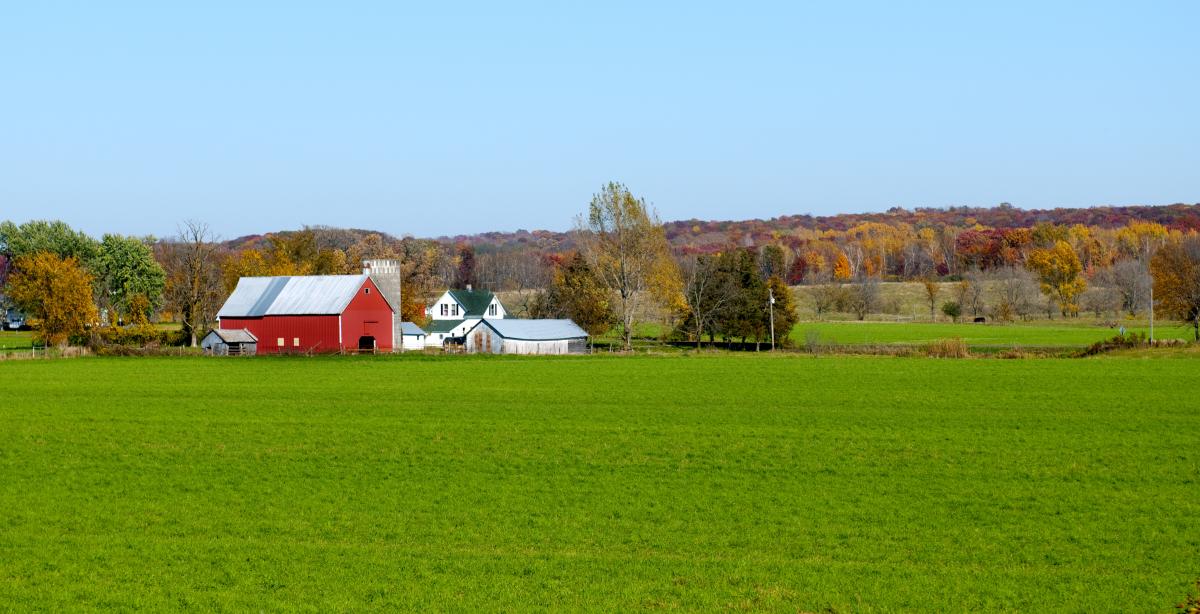By Artem Milinchuk, Founder & Head of Strategy of FarmTogether.
Both farmland and bonds can offer a long-term volatility hedge, a low-risk investment, and historically stable returns. There are differences as well: farmland investments tend to outperform bonds, benefit from inflation, and enjoy less price volatility.
There’s much to explore about farmland’s potential as an alternative to bonds. Let’s break down the role of each asset within your portfolio, how the assets differ, and why you may want to consider an allocation to farmland.
The Role of Bonds in Your Portfolio
In previous eras, bonds were a go-to for volatility-wary investors. Between November 1980 and July 1982, during the height of the 1980’s recession, equities lost just over 16.5% of their value. Meanwhile, bonds increased by more than 21.6% in that same period.
These days, however, bonds react far less to market declines: equities plummeted by nearly 51% between January 2007 and February 2009, but bonds only rose by 6.08%. In 2020, bonds only increased by 1.2% despite a 19.57% drop for equities.
10-Year T-Bill, Dow Jones, and S&P 500 Annual Performance
The Pros of Bonds
Bonds provide your portfolio with several benefits, including:
- Guaranteed returns: Fixed-rate bonds are guaranteed to pay out a certain sum upon maturity.
- Minimal volatility: The nature of bonds has historically shielded them from short-term market trends, although inflation may diminish bonds’ value.
- Some inflation protection: Bonds, generally speaking, do not account for inflation eating away at your returns. Treasury Inflation-Protected Securities, however, have floating interest rates that rise when inflation does.
- Negative stock market correlation: Bonds tend to move contrary to stock indices (with exceptions). From 1992 to 2021, investment-grade bonds and the S&P 500 enjoyed a correlation factor of 0.00, meaning the two asset classes have historically enjoyed low correlation.
The Cons of Bonds
Bond investments are by no means perfect. Consider these potential drawbacks:
- Lower return on investment: The conservative nature of bonds means you’re less likely to generate the same returns you’d get from equities.
- May not keep up with inflation: TIPS offer inflation-pegged interest rate increases, but other bonds do not. This may expose you to lower gains in terms of purchasing power if your bond matures in a high-inflation environment.
- Timing makes a major difference: If you buy bonds before an interest rate increase, such as we are seeing today, you may miss out on a greater return.
The Role of Farmland Investing in Your Portfolio
Farmland investing may not be as well-known as bonds, but the asset class can offer your portfolio many of the same advantages. Like bonds, farmland has historically offered a hedge against market volatility as well as the potential for long-term growth. Institutional and ultra-high net worth investors have sought out farmland investment opportunities since the 1960s, given farmland’s historical value as a real and stable asset.
Desire for farmland among institutional investors has exploded since 2000. There were fewer than 20 farmland-focused investment funds globally in 2005. This changed in the wake of the 2008-2009 financial crisis: more money began flocking to safe-haven investments like farmland when markets plummeted. There were 166 funds specifically focused on farmland as of 2020.
Farmland is also an essential component of the agricultural commodities market. After all, farmland is the underlying asset with which farmers generate agricultural commodities, providing positive correlative exposure to grain and livestock futures upticks.
There are advantages (and disadvantages) to farmland investing distinct from bonds. These might affect your portfolio differently depending on your investment horizon and goals.
The Pros of Farmland Investing
There are a host of advantages to farmland investing. Some of the most common include:
- Competitive returns: Farmland investments historically have more competitive annual returns than Treasury bonds. Treasury bond yields averaged 1.52% in 2021, compared to farmland’s return of 7.8%.
- Low stock market correlation: Farmland has demonstrated a low correlation with bond (-0.24) and equities markets (-0.06) over the last three decades, meaning farmland investments may not be significantly impacted by market trends.
- Long-term value: Increasing farmland scarcity is on track to collide with a worldwide doubling of demand for food by 2050, which should only cause the value of farmland to increase over time.
- Variety of investment options: Farmland investments come with a wide range of target hold periods and a bounty of different investment opportunities (crops, geographic location, and more).
The Cons of Farmland Investing
Farmland investing isn’t without its drawbacks, of course. It might not be a fit if:
- You’re not an accredited investor: Direct investments in farmland are most often limited to accredited investors.
- You want fast returns: Farmland investments are designed with the long-term in mind, particularly investments into permanent crops. They’re not a substitute for stocks or other more volatile investments.
Comparing Farmland and Bonds
Bonds and farmland both enjoy historically low volatility and stable return characteristics, especially compared to other investment types. Yet, farmland differs from bonds as far as returns are concerned, as well as the hold periods and investment methods available.
Let’s break down the differences between these two asset classes and explore why farmland might make a solid alternative to bonds within your portfolio.
Historical Returns
Bonds and farmland both have, for the most part, a stable history of positive performance. As shown below, the yearly closing price per acre tends to keep pace – if not outperform – interest rate increases on Treasury bonds. Comparatively, farmland has fewer value fluctuations, historically speaking, within the past decade and a half.
Farmland Price per Acre versus 10-Year T-Bill Interest
Except for just a handful of down markets, the average price per acre of U.S. farmland has appreciated since the 1990s. In 2008, the Great Recession caused fewer real estate developers to pursue farmland investments, which caused a slight drop. Even still, farmland did a better job sustaining value and regaining what was lost more quickly.
Farmland Value vs. S&P 500 and DJIA Annual Closing Price — 1990-Present
Risk and Volatility
Bonds and farmland investing are both touted for being risk-conscious investments that enjoy historically low volatility. Considering both from the perspective of the Sharpe Ratio, both get high marks. The higher an investment’s Sharpe Ratio, the greater the risk-adjusted return. Farmland investing clocked in at 1.21 from 1992 to 2021, while bonds had a ratio of 0.59 during the same time frame.
Market Correlation
Bonds and farmland both have a low, negative correlation with most stock indices, meaning investors can anticipate that either investment should perform better when stocks underperform. The price movement of stocks did not impact bonds as much in the past as it does today. The inverse is also true for bond prices impacting stocks.
Investing Options and Ways to Invest
There are various bond options available for investment: corporate debt, municipal bonds, and T-bills are all different forms of bonds, complete with their own interest rates. The bigger your risk appetite, the more open you might be to corporate bonds, which come with different grades to assess their risk of default.
If you’re looking for a more conservative approach to incorporating bonds into your portfolio, you’re likely going to look at Treasury bonds first. If so, you can purchase bonds through TreasuryDirect, a brokerage account, or even through exchange-traded funds (ETFs).
Farmland investing also offers a variety of investment options and methods. Most individual investors may not have the opportunity to purchase a farm themselves due to its multi-million-dollar price tag. Rather, accredited investors can pursue farmland investing in two ways: through fractional ownership companies or through REITs. The former gives you direct, fractional ownership of farmland of your choosing. The latter provides exposure to the real estate sector through a tailored portfolio (rather than direct ownership). Fractional farmland ownership behaves differently than REIT investing, which is prone to stock shocks and has more exposure to the markets.
How to Choose Between Farmland Investing and Bonds
Bonds and farmland enjoy many similarities from an investment perspective. They’re long-term investments with return rates you can track over time, and each offers a historically low, negative correlation with stocks (thus bolstering your diversification). Plus, both are well-positioned to ride out economic volatility, too.
However, today’s economic conditions may give investors a larger potential upside with farmland than bonds. Despite recent yield increases, bond rates remain lower as Fed interest rate increases are only just beginning again. On the other hand, farmland investments could have a rate of return between 2-14%, depending on the crop. This variety of farmland may also give the asset an edge for investors who want unique diversification opportunities as well.
Ultimately, the best fit for your portfolio is the investment type that complements your overall strategy. Bonds might be a good option for investors looking for a very long-term investment, even if that means making less of a return. However, in today’s environment, bond returns might not provide the same yield they once did—nor do they enjoy the same insulation from stock fluctuations they once had.
Others, accredited investors, in particular, may want to consider farmland. Those that do may find that the variety of options, target hold periods, and IRRs of farmland can provide unique advantages that bonds cannot.
About The Author:
Artem Milinchuk, Founder & CEO of FarmTogether.

Artem has over 10 years of finance experience in food, agriculture, and farmland. Prior to founding FarmTogether, Artem was employee #1 and CFO/VP of Operations at Full Harvest Technologies, a now post-Series A B2B platform for buying and selling produce. He previously worked at Ontario Teachers' Pension Plan, Sprott Resource Holdings, E&Y and PwC. Artem holds an MBA from The Wharton School, and a BA and MA in Economics from the Higher School of Economics.




